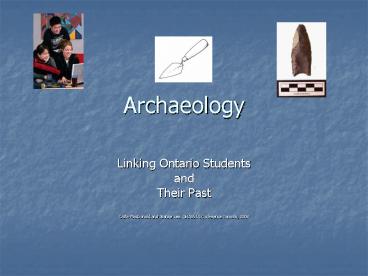Archaeology - PowerPoint PPT Presentation
1 / 13
Title:
Archaeology
Description:
Careful records are kept through mapping, photography, and note taking. ... and Ontario Archaeology Teaching Resource from www.canadianarchaeology.com ... – PowerPoint PPT presentation
Number of Views:35
Avg rating:3.0/5.0
Title: Archaeology
1
Archaeology
- Linking Ontario Students
- and
- Their Past
- Cathy MacDonald and Joanne Lea OHASSTA
Conference Toronto, 2008
2
What is archaeology?
- the study of the HUMAN past from the examination
of remains of material culture - -artifacts (materials modified and used by humans
e.g. an axe) - -ecofact (modification of the environment by
humans e.g. a ditch) - can be part of Anthropology, History
- licensed and regulated by the government
3
(No Transcript)
4
We all know what it looks like...
5
...or do we? Because, archaeology
takes place right here, in CANADA.
6
Archaeology is a study that uses scientific
methods.(sorry...no whips, crystal skulls or
tomb raiding)
- A research design based on hypotheses is created.
- Initial research is conducted (documentary and
oral sources.)
7
Surveys and tests are conducted to see if more
research is required.
8
Excavation may be undertaken.
9
Careful records are kept through mapping,
photography, and note taking.
10
Evidence is conserved, catalogued, analysed and
interpreted to add to our understanding of the
past.
11
Oral tradition Turtle Island formed on the back
of a turtle from that came all life the people
have always been here.
Archaeological information about peopling of
Canada, to date...
5 000 B.P. Thule from Siberia and Islands by sea
B.P. means before present
40 000-12 000 B.P. from Siberia via Beringia
1 000 B.P. Norse by sea
500 B.P. European fishermen, explorers and
colonisers by sea
10 000 5 000 B.P. following melting glaciers
from the south by land
12
Archaeology in grade 7 and 8 classes
13
Archaeology and grade 7 and 8 classes
- Applies to the curriculum for studying
interaction between First Nations and Europeans
establishment of European colonies daily life in
Acadia, New France, British North America,
Ruperts Land, the Yukon, critical thinking. - Applies to studies of methods for studying the
past primary sources (e.g. - artifacts, documents) - their benefits and
limitations compared to secondary sources. - Can integrate a variety of subject areas
(History, Geography, Math, Science, Arts.
Language - English, French and First Nations
Languages). - Hands-on.
- Resources available e.g. speakers, sites,
museums, - Canadian Archaeological Association K-12
curriculum with downloadable lessons and Ontario
Archaeology Teaching Resource from
www.canadianarchaeology.com









![[DOWNLOAD]⚡️PDF✔️ What is Media Archaeology? PowerPoint PPT Presentation](https://s3.amazonaws.com/images.powershow.com/10051378.th0.jpg?_=20240609108)
![[DOWNLOAD]PDF What is Media Archaeology? PowerPoint PPT Presentation](https://s3.amazonaws.com/images.powershow.com/10052078.th0.jpg?_=202406101212)
















![[DOWNLOAD]⚡️PDF✔️ The Archaeology of Political Structure: Settlement Analysis in a Classic Maya PowerPoint PPT Presentation](https://s3.amazonaws.com/images.powershow.com/10056655.th0.jpg?_=202406160711)



